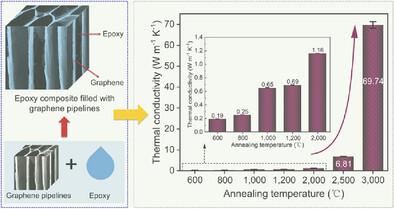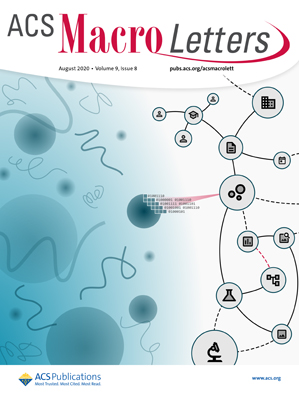Novel Graphene-Epoxy Composite with Aligned Architecture and Ultrahigh Thermal Conductivity
IF 5.1
Q1 POLYMER SCIENCE
引用次数: 0
Abstract
Because of the surge in the power density of electronic devices, there is an urgent need for improvements in the thermal conductivity of packaging materials. Nowadays, epoxy composites supplemented with thermally conductive fillers are widely used for this purpose, but unfortunately, none of them can satisfactorily meet industrial requirements. Herein, this article reports on a novel method to prepare well-shaped and highly ordered graphene-epoxy composite architecture; that is, the epoxy infiltrates into tubular graphene columns that have been restored to the high thermally conductive structure of graphene. As a result, the newly developed graphene-epoxy composite exhibits record-high thermal conductivity of 69.74 W m−1 K−1 with filler content of only 11.22 wt.%. The unprecedentedly high thermal conductivity stems from the construction of thermally conductive channels and restoration of the inherent π–π conjugate structure of graphene. These findings not only offer a breakthrough in packaging materials with significantly enhanced thermal conductivity but also provide a promising avenue for the development of other advanced graphene-added composites.

具有对齐结构和超高导热性的新型石墨烯-环氧树脂复合材料
由于电子设备的功率密度急剧增加,因此迫切需要改善包装材料的导热性能。目前,添加导热填料的环氧树脂复合材料已被广泛应用,但遗憾的是,它们都无法满足工业要求。本文报告了一种制备形状良好且高度有序的石墨烯-环氧复合材料结构的新方法,即环氧渗入管状石墨烯柱中,恢复石墨烯的高导热结构。因此,新开发的石墨烯-环氧复合材料的热导率达到了创纪录的 69.74 W m-1 K-1,而填料含量仅为 11.22 wt.%。前所未有的高导热率源于导热通道的构建以及石墨烯固有的 π-π 共轭结构的恢复。这些发现不仅为具有显著增强导热性的包装材料提供了一个突破口,而且为开发其他添加石墨烯的先进复合材料提供了一个前景广阔的途径。
本文章由计算机程序翻译,如有差异,请以英文原文为准。
求助全文
约1分钟内获得全文
求助全文
来源期刊
CiteScore
10.40
自引率
3.40%
发文量
209
审稿时长
1 months
期刊介绍:
ACS Macro Letters publishes research in all areas of contemporary soft matter science in which macromolecules play a key role, including nanotechnology, self-assembly, supramolecular chemistry, biomaterials, energy generation and storage, and renewable/sustainable materials. Submissions to ACS Macro Letters should justify clearly the rapid disclosure of the key elements of the study. The scope of the journal includes high-impact research of broad interest in all areas of polymer science and engineering, including cross-disciplinary research that interfaces with polymer science.
With the launch of ACS Macro Letters, all Communications that were formerly published in Macromolecules and Biomacromolecules will be published as Letters in ACS Macro Letters.

 求助内容:
求助内容: 应助结果提醒方式:
应助结果提醒方式:


